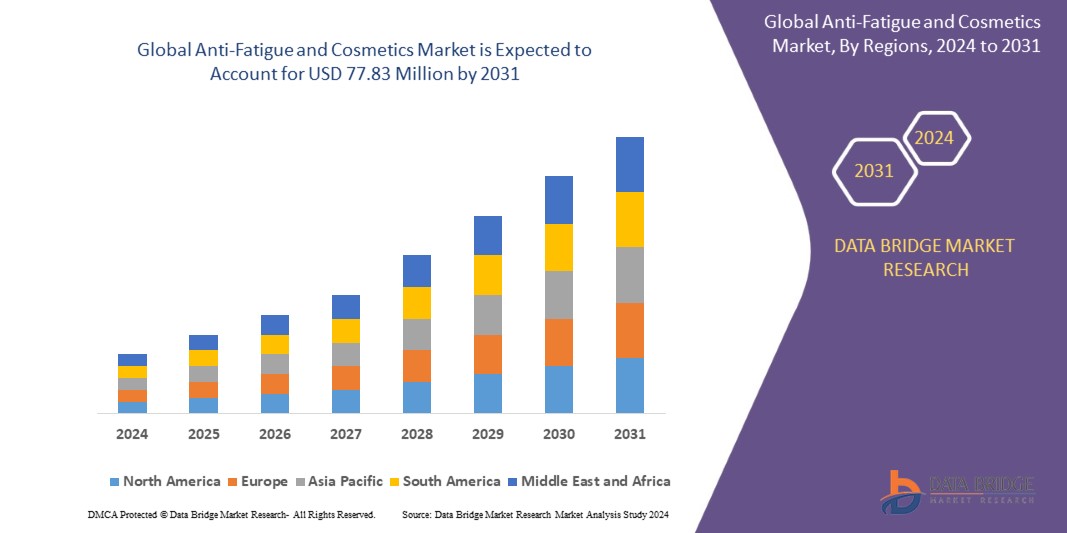世界の抗疲労および化粧品市場の規模、シェア、トレンド分析レポート
Market Size in USD Billion
CAGR :
% 
| 2024 –2031 | |
| USD 51.10 Million | |
| USD 77.83 Million | |
|
|
|
世界の疲労防止および化粧品市場のセグメンテーション、製品別(クリーム、オイル、ローション、美容液、ジェル、その他)、最終用途別(女性、男性)、流通チャネル別(オフライン、オンライン) - 2031 年までの業界動向と予測。
疲労回復と化粧品市場分析
疲労防止および化粧品の世界市場は、スキンケアと健康に対する消費者の意識の高まりにより、急成長を遂げています。この拡大は、目の下のクマや肌のくすみなど、疲労の兆候に対処する製品の需要の高まりと、パーソナライズされた自然派化粧品への関心の高まりによって推進されています。高度な成分と最先端の技術を特徴とする製品配合の革新も、市場の成長を後押ししています。大手企業は、市場での存在感を高めるために、提供品を多様化し、戦略的パートナーシップを形成しています。都市生活と環境要因が疲労の一因となっているため、市場は、特に新興地域とオンライン小売プラットフォームを通じて、継続的な拡大が見込まれます。
疲労回復・化粧品市場規模
世界の抗疲労および化粧品市場規模は、2023年に5,110万米ドルと評価され、2024年から2031年の予測期間中に5.4%のCAGRで成長し、2031年には7,783万米ドルに達すると予測されています。市場価値、成長率、セグメンテーション、地理的範囲、主要プレーヤーなどの市場シナリオに関する洞察に加えて、Data Bridge Market Researchがまとめた市場レポートには、詳細な専門家分析、価格分析、ブランドシェア分析、消費者調査、人口統計分析、サプライチェーン分析、バリューチェーン分析、原材料/消耗品概要、ベンダー選択基準、PESTLE分析、ポーター分析、規制枠組みも含まれています。
疲労回復と化粧品市場の動向
「健康ソリューションに対する意識、ストレスレベル、需要の高まり」
スキンケアと健康に対する消費者の意識の高まりにより、目の下のクマや肌のくすみなど、疲労に関連する問題に対処する製品の需要が高まっています。パーソナライズされた自然派化粧品へのシフトが顕著で、カスタマイズされたスキンケアソリューションと持続可能で環境に優しい原料が好まれています。
処方における技術的進歩も重要な役割を果たしており、高性能成分や斬新なデリバリーシステムなどのイノベーションが抗疲労製品の有効性を高めています。ブランドは、ペプチド、抗酸化物質、ヒアルロン酸などの成分を取り入れ、優れた効果を提供するための研究開発に多額の投資を行っています。デジタルおよびeコマースプラットフォームの台頭により市場はさらに形成され、消費者は多様な製品やパーソナライズされた推奨事項に簡単にアクセスできるようになりました。ソーシャルメディアやインフルエンサーの推奨は、消費者の好みに影響を与え、ブランドエンゲージメントを高めています。
都会のライフスタイルや、大気汚染や睡眠不足などの環境ストレスが疲労を悪化させ、効果的なスキンケアソリューションの需要が高まっています。大手業界企業は、製品ラインを多様化し、戦略的パートナーシップを結んで市場範囲を拡大することで対応し、この分野の継続的な成長と革新の基盤を築いています。
レポートの範囲と市場セグメンテーション
|
属性 |
世界の抗疲労および化粧品の主要市場に関する洞察 |
|
セグメンテーション |
|
|
対象国 |
米国、カナダ、メキシコ、ドイツ、フランス、英国、オランダ、スイス、ベルギー、ロシア、イタリア、スペイン、トルコ、その他のヨーロッパ諸国、中国、日本、インド、韓国、シンガポール、マレーシア、オーストラリア、タイ、インドネシア、フィリピン、その他のアジア太平洋諸国、サウジアラビア、UAE、南アフリカ、エジプト、イスラエル、その他の中東およびアフリカ諸国、ブラジル、アルゼンチン、その他の南米諸国 |
|
主要な市場プレーヤー |
ロレアル(フランス)、エスティ ローダー カンパニーズ インク(米国)、プロクター アンド ギャンブル カンパニー(米国)、ユニリーバ(英国)、ジョンソン アンド ジョンソン(米国)、コティ インク(米国)、レブロン インク(米国)、エイボン プロダクツ インク(英国)、アモーレ パシフィック コーポレーション(韓国)、クラランス グループ(フランス)、バーツビーズ(クロロックス)(米国)、メアリー ケイ インク(米国)、ポンズ(ユニリーバ)(英国)、ナチュラ アンド コー(ブラジル)、オリ フレーム コスメティックス(スウェーデン)、ザ ボディ ショップ(ナチュラ アンド コー)(英国)、サリー ハンセン(コティ インク)(米国) |
|
市場機会 |
|
|
付加価値データ情報セット |
Data Bridge Market Research がまとめた市場レポートには、市場価値、成長率、セグメンテーション、地理的範囲、主要プレーヤーなどの市場シナリオに関する洞察に加えて、詳細な専門家分析、価格分析、ブランドシェア分析、消費者調査、人口統計分析、サプライ チェーン分析、バリュー チェーン分析、原材料/消耗品概要、ベンダー選択基準、PESTLE 分析、ポーター分析、規制枠組みも含まれています。 |
疲労回復と化粧品市場の定義
疲労防止および化粧品には、目の下のクマや肌のくすみなどの疲労の兆候に対処するために特別に配合された製品が含まれます。疲れた肌やストレスを受けた肌を若返らせ、見た目を良くするように設計された高度な成分と技術を使用したスキンケアおよび化粧品ソリューションが特徴です。
疲労回復と化粧品市場の動向
ドライバー
- スキンケアへの意識の高まりにより、疲労回復製品の需要が増加
スキンケアと健康に対する意識が高まるにつれ、疲労防止製品の需要が高まっています。消費者が肌の健康、老化、全体的な外見に重点を置くようになるにつれ、これらの問題に対処するための解決策を求める傾向が強まっています。肌を活性化しリフレッシュさせることを目的とした疲労防止製品は、疲労の兆候を軽減し、肌の活力を高める効果があることから、ますます人気が高まっています。この関心の高まりは、個人の健康目標や若々しく活力のある外見への欲求に駆り立てられた、積極的なスキンケアへの幅広い傾向を反映しています。
例えば、
- 2024 年 9 月、Vogue Business は、世界的な美容トレンドやパーソナライズされた製品情報へのアクセスの増加により、知識豊富なインドのスキンケア消費者が急増していると報告しています。この変化により、消費者は高品質で透明性があり、科学的に裏付けられたスキンケア ソリューションを求めており、より賢明な選択が求められています。
ソーシャルメディアによる消費者の関心の高まりと売上の向上
ソーシャルメディアや有名人による宣伝は、さまざまな製品、特に化粧品の消費者の関心を高め、売上を伸ばす上で重要な役割を果たしています。インフルエンサーや有名人は、プラットフォームを使用して抗疲労製品やスキンケア製品を強調して宣伝することで、大きな認知度と信頼を生み出しています。この広範な露出は製品の認知度を高めるだけでなく、有名人の推奨は信頼されることが多いため、消費者の購買選択を形作ります。その結果、製品の人気と売上の上昇は、ソーシャルメディアと有名人の影響が現代の消費者行動と市場動向に大きく影響していることを強調しています。
機会
- 化粧品や抗疲労剤における環境に優しい天然成分の需要増加
バイオテクノロジーと皮膚科学は、遺伝学と分子学の知見を活用して、パーソナライズされたスマート化粧品の開発を進めています。これらのイノベーションにより、個々の肌のタイプや状態に特化した製品の開発が可能になり、効果を高め、副作用を最小限に抑えることができます。リアルタイム データとウェアラブル テクノロジーを備えたスマート化粧品は、環境要因と個人の肌のニーズに基づいて処方を調整します。
- バイオテクノロジーと皮膚科学がパーソナライズされたスマート化粧品の成長を促進
化粧品における環境に優しい天然成分への嗜好の高まりは、より持続可能で健康志向の選択肢への動きを反映しています。消費者は、合成化学物質や環境に有害な成分を含まない製品を選んでいます。この変化は抗疲労治療にも影響を及ぼし、穏やかで効果的な効果を持つ天然エキスやオーガニック処方が好まれています。これらの成分は環境に優しい原則をサポートするだけでなく、より安全で透明性のあるスキンケアソリューションの需要にも対応しています。ブランドはこれに応えて、環境の持続可能性と消費者の健康の両方に一致するように製品を改良しています。
制約/課題
- 生産コストが高いため、製品の手頃な価格と市場への展開が制限される
高い生産コストは、抗疲労剤および化粧品市場にとって大きな制約であり、製品価格の上昇と購入しやすさの低下につながります。製造費の上昇は小売価格の上昇につながり、特に低所得者層の幅広い消費者のアクセスを制限します。この価格への敏感さは、より広範な市場への導入を妨げ、成長を鈍化させる可能性があります。さらに、高い生産コストの経済的負担は、企業がマーケティング、流通、イノベーションに投資する能力を制限する可能性があります。これらの課題を克服するには、企業はコスト削減戦略に重点を置き、生産プロセスを合理化し、品質と入手しやすさを維持しながら価格競争力を維持するための代替手段を模索する必要があります。
この市場レポートでは、最近の新しい開発、貿易規制、輸出入分析、生産分析、バリュー チェーンの最適化、市場シェア、国内および現地の市場プレーヤーの影響、新たな収益源の観点から見た機会の分析、市場規制の変更、戦略的市場成長分析、市場規模、カテゴリ市場の成長、アプリケーションのニッチと優位性、製品の承認、製品の発売、地理的拡張、市場における技術革新の詳細が提供されます。市場に関する詳細情報を取得するには 、アナリストの概要について Data Bridge Market Research にお問い合わせください。当社のチームが、市場の成長を達成するための情報に基づいた市場決定を行うお手伝いをします。
疲労回復と化粧品市場の範囲
市場は、製品、エンドユーザー、流通チャネルに基づいてセグメント化されています。これらのセグメントの成長は、業界のわずかな成長セグメントの分析に役立ち、ユーザーに貴重な市場の概要と市場の洞察を提供し、コア市場アプリケーションを特定するための戦略的決定を下すのに役立ちます。
製品
- クリーム
- 油
- ローション
- 血清
- ゲル
- その他
エンドユーザー
- 女性
- 男性
流通チャネル
- オフライン
- オンライン
疲労回復・化粧品市場の地域分析
市場が分析され、上記のように製品、エンドユーザー、流通チャネル別に市場規模の洞察と傾向が提供されます。
市場に含まれる国は、米国、カナダ、メキシコ、ドイツ、フランス、英国、オランダ、スイス、ベルギー、ロシア、イタリア、スペイン、トルコ、その他のヨーロッパ諸国、中国、日本、インド、韓国、シンガポール、マレーシア、オーストラリア、タイ、インドネシア、フィリピン、その他のアジア太平洋諸国、サウジアラビア、UAE、南アフリカ、エジプト、イスラエル、その他の中東およびアフリカ諸国、ブラジル、アルゼンチン、その他の南米諸国です。
アジア太平洋地域は、スキンケア製品に対する消費者の需要の増加、可処分所得の増加、そして多様な人口統計における健康と美容への関心の高まりにより、市場を支配しています。
中東とアフリカは、可処分所得の増加、美容業界の急成長、高品質のスキンケア製品や健康製品に対する消費者の関心の高まりに支えられ、世界の抗疲労・化粧品市場で最も急速に成長している地域です。
レポートの国別セクションでは、市場の現在および将来の傾向に影響を与える国内市場における個別の市場影響要因と規制の変更も提供しています。下流および上流のバリュー チェーン分析、技術動向、ポーターの 5 つの力の分析、ケース スタディなどのデータ ポイントは、個々の国の市場シナリオを予測するために使用される指標の一部です。また、国別データの予測分析を提供する際には、グローバル ブランドの存在と可用性、および地元および国内ブランドとの競争が激しいか少ないために直面する課題、国内関税と貿易ルートの影響も考慮されます。
疲労回復・化粧品市場シェア
市場競争環境では、競合他社の詳細が提供されます。含まれる詳細には、会社概要、会社の財務状況、収益、市場の可能性、研究開発への投資、新しい市場への取り組み、世界的なプレゼンス、生産拠点と施設、生産能力、会社の強みと弱み、製品の発売、製品の幅と広さ、アプリケーションの優位性などがあります。提供される上記のデータ ポイントは、市場に関連する会社の焦点にのみ関連しています。
市場で活動する抗疲労および化粧品のマーケットリーダーは次のとおりです。
- ロレアル(フランス)
- エスティ ローダー カンパニーズ インク (米国)
- プロクター・アンド・ギャンブル社(米国)
- ユニリーバ(英国)
- ジョンソン・エンド・ジョンソン(米国)
- コティ社(米国)
- レブロン社(米国)
- エイボンプロダクツ社(英国)
- アモーレパシフィック株式会社(韓国)
- クラランスグループ(フランス)
- バーツビーズ(クロロックス)(米国)
- メアリーケイ社(米国)
- ポンズ(ユニリーバ)(イギリス)
- ナチュラ&Co(ブラジル)
- オリフレイムコスメティックス(スウェーデン)
- ザ・ボディショップ(ナチュラ&コー)(イギリス)
- サリーハンセン(コティ社)(米国)
SKU-
世界初のマーケットインテリジェンスクラウドに関するレポートにオンラインでアクセスする
- インタラクティブなデータ分析ダッシュボード
- 成長の可能性が高い機会のための企業分析ダッシュボード
- カスタマイズとクエリのためのリサーチアナリストアクセス
- インタラクティブなダッシュボードによる競合分析
- 最新ニュース、更新情報、トレンド分析
- 包括的な競合追跡のためのベンチマーク分析のパワーを活用
調査方法
データ収集と基準年分析は、大規模なサンプル サイズのデータ収集モジュールを使用して行われます。この段階では、さまざまなソースと戦略を通じて市場情報または関連データを取得します。過去に取得したすべてのデータを事前に調査および計画することも含まれます。また、さまざまな情報ソース間で見られる情報の不一致の調査も含まれます。市場データは、市場統計モデルと一貫性モデルを使用して分析および推定されます。また、市場シェア分析と主要トレンド分析は、市場レポートの主要な成功要因です。詳細については、アナリストへの電話をリクエストするか、お問い合わせをドロップダウンしてください。
DBMR 調査チームが使用する主要な調査方法は、データ マイニング、データ変数が市場に与える影響の分析、および一次 (業界の専門家) 検証を含むデータ三角測量です。データ モデルには、ベンダー ポジショニング グリッド、市場タイムライン分析、市場概要とガイド、企業ポジショニング グリッド、特許分析、価格分析、企業市場シェア分析、測定基準、グローバルと地域、ベンダー シェア分析が含まれます。調査方法について詳しくは、お問い合わせフォームから当社の業界専門家にご相談ください。
カスタマイズ可能
Data Bridge Market Research は、高度な形成的調査のリーダーです。当社は、既存および新規のお客様に、お客様の目標に合致し、それに適したデータと分析を提供することに誇りを持っています。レポートは、対象ブランドの価格動向分析、追加国の市場理解 (国のリストをお問い合わせください)、臨床試験結果データ、文献レビュー、リファービッシュ市場および製品ベース分析を含めるようにカスタマイズできます。対象競合他社の市場分析は、技術ベースの分析から市場ポートフォリオ戦略まで分析できます。必要な競合他社のデータを、必要な形式とデータ スタイルでいくつでも追加できます。当社のアナリスト チームは、粗い生の Excel ファイル ピボット テーブル (ファクト ブック) でデータを提供したり、レポートで利用可能なデータ セットからプレゼンテーションを作成するお手伝いをしたりすることもできます。





